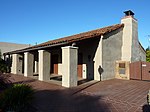Yew Chung International School of Silicon Valley
Yew Chung International School of Silicon Valley (YCISSV; Chinese: 美國矽谷耀中國際學校) is a private Preschool, Elementary and Middle School in the San Francisco Bay Area that provides an international education with an emphasis on Chinese Studies. YCIS is a non-profit 501(c)3 and is accredited by the Western Association of Schools and Colleges (WASC). The main campus is located at 310 Easy Street, Mountain View, California. The preschool campus is .4 miles away at 199 E. Middlefield Road, also in Mountain View. YCIS Silicon Valley is part of the Yew Chung Education Foundation, which was established in 1932. YCIS also has schools in Hong Kong, Shanghai, Beijing, Chongqing and Qingdao. Yew Chung International School of Silicon Valley offers a Chinese-English bilingual program. While English is the primary language of instruction, YCIS focuses on bilingual learning through the utilization of the "co-teaching" model (classes are administered by both Western and Chinese teachers, in order to encourage fluency.)
Excerpt from the Wikipedia article Yew Chung International School of Silicon Valley (License: CC BY-SA 3.0, Authors).Yew Chung International School of Silicon Valley
Easy Street, Mountain View
Geographical coordinates (GPS) Address Nearby Places Show on map
Geographical coordinates (GPS)
| Latitude | Longitude |
|---|---|
| N 37.4 ° | E -122.067 ° |
Address
German International School of Silicon Valley
Easy Street
94041 Mountain View
California, United States
Open on Google Maps








